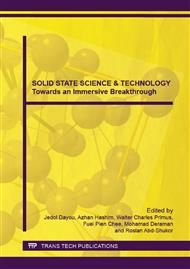[1]
Deka, M., Kumar, A. (2010) Enhanced electrical and electrochemical properties of PMMA–clay nanocomposite gel polymer electrolytes. Electrochimica Acta, 55, 1836–1842.
DOI: 10.1016/j.electacta.2009.10.076
Google Scholar
[2]
Osman, Z., Ghazali, M.I.M., Othman, L., Isa, K.B.M. (2012) AC ionic conductivity and DC polarization method of lithium ion transport in PMMA–LiBF4 gel polymer electrolytes. Results in Physics, 2, 1–4.
DOI: 10.1016/j.rinp.2011.12.001
Google Scholar
[3]
Kufian, M.Z., Aziz, M.F., Shukur, M.F., Rahim, A.S., Ariffin, N.E., Shuhaimi, N.E.A., Majid, S.R., Yahya, R., Arof, A.K. (2012) PMMA–LiBOB gel electrolyte for application in lithium ion batteries. Solid State Ionics, 208, 36–42.
DOI: 10.1016/j.ssi.2011.11.032
Google Scholar
[4]
Sivakumar, M., Subadevi, R., Rajendran, S., Wu, H. C, Wu, N.L. (2007) Compositional effect of PVdF–PEMA blend gel polymer electrolytes for lithium polymer batteries. European Polymer Journal, 43, 4466–4473.
DOI: 10.1016/j.eurpolymj.2007.08.001
Google Scholar
[5]
Latif, F.A., Aziz, M., Katun, K., Ali, M.A.M., Yahya, M.Z. (2006) The role and impact of rubber in poly(methyl methacrylate)/lithium triflate electrolyte. Journal of Power Sources, 159, 1401–1404.
DOI: 10.1016/j.jpowsour.2005.12.007
Google Scholar
[6]
Su'ait, M.S., Ahmad, A., Hamzah, H., Rahman, M.Y.A. (2011).
Google Scholar
[7]
Sharil, F.M. Z, Latif, Famiza, A.L. (2013) SiO2 filler as interface modifier in PMMA/ENR 50 electrolytes. Advanced Materials Research, 812, 120-124.
DOI: 10.4028/www.scientific.net/amr.812.120
Google Scholar
[8]
Kumar, K.K., Ravi, M., Pavani, Y., Bhavani, S. Sharma, A.K., Rao, V.V.R.N. (2012) Electrical conduction mechanism in NaCl complexed PEO/PVP polymer blend electrolytes. Journal of Non-Crystalline Solids, 358 (21), 3205-3211.
DOI: 10.1016/j.jnoncrysol.2012.08.022
Google Scholar
[9]
Noriman, N. Z., Ismail, H. and Rashid, A. A. (2010).
Google Scholar
[10]
Shanmukaraj, D., Wang, G.X., Murugan, R. Liu, H.K. (2008) Ionic conductivity and electrochemical stabilityof poly(methylmethacrylate)–poly(ethylene oxide) blend-ceramic fillers composites. Journal of Physics and Chemistry of Solids, 69, 243–248.
DOI: 10.1016/j.jpcs.2007.08.072
Google Scholar
[11]
Bac, A., Ciosek, M., Bukat, M., Marczewski, M., Marczewska, H., Wieczorek, W. (2006).
Google Scholar
[12]
Thakur, A. K, Hashmi, S.A. (2010) Polymer matrix–filler interaction mechanism for modified ion transport and glass transition temperature in the polymer electrolyte composites. Solid State Ionics, 181, 1270–1278.
DOI: 10.1016/j.ssi.2010.06.055
Google Scholar
[13]
Zhang, S., Lee, J.Y., Hong, L. (2004) Visualization of particle distribution in composite polymer electrolyte systems. Journal of Power Sources, 126(1–2), 125-133.
DOI: 10.1016/j.jpowsour.2003.08.011
Google Scholar
[14]
Halma, M., Bail, A., Wypych, F., Nakagaki, S. (2006) Catalytic activity of anionic iron(III) porphyrins immobilized on grafted disordered silica obtained from acidic leached chrysotile. Journal of Molecular Catalysis A: Chemical, 243(1), 44-51.
DOI: 10.1016/j.molcata.2005.08.019
Google Scholar
[15]
Kim. M.T. (1997) Deposition behavior of hexamethydisiloxane films based on the FTIR analysis of Si–O–Si and Si–CH3 bonds. Thin Solid Films, 311(1–2), 157-163.
DOI: 10.1016/s0040-6090(97)00683-4
Google Scholar
[16]
Cao, J., Wang, L., Shang, Y., Fang, M., Deng, L., Gao, J., Li, J. Chen, H., He, X. (2013) Dispersibility of nano-TiO2 on performance of composite polymer electrolytes for Li-ion batteries. Electrochimica Acta, 111, 674-679.
DOI: 10.1016/j.electacta.2013.08.048
Google Scholar
[17]
Fan, L., Nana, C.W., Zhao, S. (2003) Effect of modified SiO2 on the properties of PEO-based polymer electrolytes. Solid State Ionics, 164(1–2), 81-86.
DOI: 10.1016/j.ssi.2003.08.004
Google Scholar
[18]
Wang, Y.Y., Fan, F., Agapov, A.L., Saito, T., Yang, J., Yu, X., Hong, K., Mays, J., Sokolov, A.P. (2014) Examination of the fundamental relation between ionic transport and segmental relaxation in polymer electrolytes. Polymer, 55(16), 4067-4076.
DOI: 10.1016/j.polymer.2014.06.085
Google Scholar
[19]
Rajendran, S., Uma, T. (2000) Effect of ceramic oxide on PMMA based polymer electrolyte systems. Materials Letters, 45 (3–4), 191-196.
DOI: 10.1016/s0167-577x(00)00103-8
Google Scholar
[20]
Rao, M, m Geng, X., Liao, Y., Hu, S., Li, W. (2012) Preparation and performance of gel polymer electrolyte based on electrospun polymer membrane and ionic liquid for lithium ion battery. Journal of Membrane Science, 399–400, 37-42.
DOI: 10.1016/j.memsci.2012.01.021
Google Scholar


